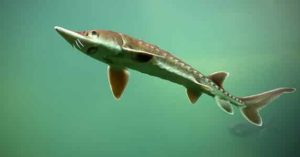FOR IMMEDIATE RELEASE
Lawsuit Launched to Force Trump Administration to Protect Lake Sturgeon
Less Than 1% of Fish Population Remains in Great Lakes, Mississippi River
Contact: Jeff Miller, (510) 499-9185, jmiller@biologicaldiversity.org
 CHICAGO— Conservation groups sent a notice today of their intent to sue the U.S. Fish and Wildlife Service for delaying a determination of whether lake sturgeon will be protected under the Endangered Species Act.
CHICAGO— Conservation groups sent a notice today of their intent to sue the U.S. Fish and Wildlife Service for delaying a determination of whether lake sturgeon will be protected under the Endangered Species Act.
The Service made an initial finding earlier this year that listing the sturgeon as threatened or endangered may be warranted. But the agency missed a May 2019 deadline for determining whether the giant, ancient fish actually warrants protection.
“These ancient survivors swam with dinosaurs 200 million years ago, but sturgeon need our help to survive climate change and the damage we’ve done to their river and lake habitats,” said Jeff Miller at the Center for Biological Diversity. “Lake sturgeon are an integral part of the Great Lakes. If they’re going to be part of the region’s future, we need a concerted effort to remove dams and restore rivers.”
“We hope this will bring a swift resolution on Endangered Species Act protection so we can get to the critical and urgent work of restoring lake sturgeon in the Great Lakes and Mississippi River basin,” said Kim Knowles with Prairie Rivers Network.
“The lake sturgeon’s listing and accompanying recovery efforts are long overdue, and we look forward to this magnificent fish thriving once again in the Ohio River basin and Lake Michigan,” said Tim Maloney with the Hoosier Environmental Council.
The lake sturgeon is an ancient fish that lives primarily in the Great Lakes and the Mississippi River basin. Sturgeon can live up to 100 years, grow more than 8 feet long, and weigh nearly 300 pounds. The species’ numbers have declined more than 99% over the past century because of overfishing, dams and pollution. There are now only nine remaining populations in the United States with more than 1,000 adult fish.
A May 2018 petition by the Center for Biological Diversity requested a “threatened” listing under the Endangered Species Act for all lake sturgeon in the United States, or alternatively separately listing distinct populations of lake sturgeon as threatened or endangered.
The Service made an initial finding in August 2019 that protecting the lake sturgeon may be warranted and that there may be distinct sturgeon populations in Lake Superior, western Lake Michigan, the upper Mississippi River basin, and the Ohio River basin. The Service initiated a scientific status review, with a public comment period running through Dec. 31, 2020.
The Center for Biological Diversity, Fishable Indiana Streams for Hoosiers, Hoosier Environmental Council and Prairie Rivers Network jointly filed today’s notice. The organizations are represented by the Abrams Environmental Law Clinic at the University of Chicago Law School.
Background
In the late 1800s, before commercial fisheries decimated lake sturgeon runs, more than 15 million lake sturgeon lived in the Great Lakes. They are now reduced to less than 1% of historic levels, with limited natural recovery of most remaining spawning populations.
Dams and hydroelectric facilities continue to harm lake sturgeon by blocking access to spawning habitat, fragmenting sturgeon populations and altering stream flows. Other threats to sturgeon include river dredging and channelization, habitat fragmentation, climate change and invasive species.
Many states and tribal organizations are working to restore sturgeon spawning populations. Most states within the fish’s range prohibit or limit harvest. Although many current restoration efforts are aimed at bringing lake sturgeon back to rivers and tributaries where they once spawned, depleted sturgeon populations take many decades to recover, and the vast majority of spawning runs have been lost.
The Center for Biological Diversity is a national, nonprofit conservation organization with more than 1.6 million members and online activists dedicated to the protection of endangered species and wild places.







